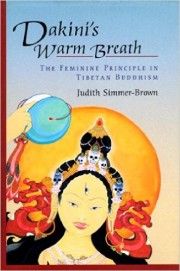 L’emblème premier du féminin dans le bouddhisme tibétain est la dakini, ou «danseuse du ciel», une esprit féminin semi courroucé qui se manifeste dans les visions, les rêves et les expériences de méditation. Les érudits occidentaux et les interprètes du symbole de la dakini, influencés par la psychologie junguienne et la théologie féministe de la déesse, ont façonné une critique contemporaine du bouddhisme tibétain dans laquelle la dakini est regardée comme une «ombre» psychologique, un féminin salvateur ou un produit objectivé des fantasmes patriarcaux. Selon Judith Simmer-Brown, qui écrit du point de vue d’une pratiquante expérimentée du bouddhisme tibétain, ces interprétations sont insuffisantes.
L’emblème premier du féminin dans le bouddhisme tibétain est la dakini, ou «danseuse du ciel», une esprit féminin semi courroucé qui se manifeste dans les visions, les rêves et les expériences de méditation. Les érudits occidentaux et les interprètes du symbole de la dakini, influencés par la psychologie junguienne et la théologie féministe de la déesse, ont façonné une critique contemporaine du bouddhisme tibétain dans laquelle la dakini est regardée comme une «ombre» psychologique, un féminin salvateur ou un produit objectivé des fantasmes patriarcaux. Selon Judith Simmer-Brown, qui écrit du point de vue d’une pratiquante expérimentée du bouddhisme tibétain, ces interprétations sont insuffisantes.
Commentaire sur Amazon :
This book is highly readable, accurate, and informative. Beyond that, it is true to the essence of Vajrayana Buddhist teaching. Judith Simmer-Brown is both chairwoman of the religious studies department of Naropa University, and an acharya, an empowered teacher, of the Shambhala lineage of Tibetan Buddhism. It is inspired and useful reading for the practitioner of Vajrayana teachings, and should also be of benefit to someone who is contemplating that path but has not yet joined it. Her sources include personal meetings with and the oral and written teachings of several great modern teachers including Chogyam Trungpa, Khenpo Tsultrim Gyamtso Rinpoche, and Khenchen Thrangu Rinpoche, as well as many great historical teachers and texts, and the existing academic literature on the subject.
Simmer-Brown’s treatment of the dakini is organized around a poem by Khenpo Tsultrim Gyamtso Rinpoche, reprinted in the book, which speaks of the secret dakini, the inner dakini, the outer dakini, and the outer-outer dakini. The last of these is the dakini as a human woman. The discussion of these four is powerful and leisurely, and diffuses many possible misunderstandings along the way. The book really covers the entire vajrayana path. It discusses the three roots: guru, yidam and protector. It contains an amazingly lucid discussion of the mandala principle. It discusses the generation and completion stages of vajrayana practice. It explains how the transmission of the dharma across generations is kept both authentic and up-to-date by means of both the ear whispered lineage and the discovered treasure (terma) lineage, and discusses the role of the dakini in both of these. Indeed, the book appears to give away too many secrets, but what keeps it pure is the author’s veneration of her teachers, her profound respect and insight into the subject, and the constant grounding of the Vajrayana in the view of Mahayana Buddhism.







